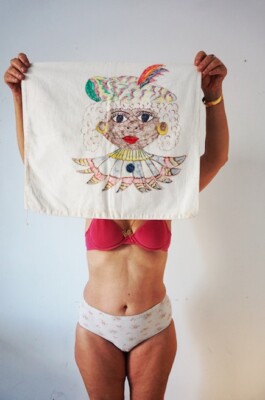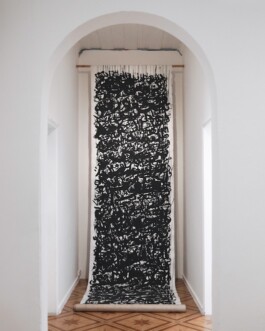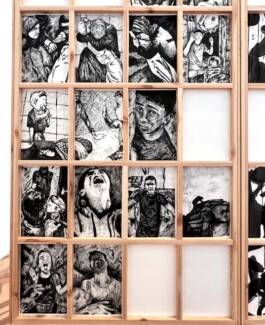TAMAR OOSTERHOF & TAHA AFEFE
Place of Residency
Ateliers Höherweg 271
Tamar Oosterhof (*1987) was born in Amsterdam and raised on Kibbutz Yizre’el. She currently lives in Jaffa. She graduated from the School of Visual Theatre (2012–2016) and holds a Bachelor’s degree (with honors) and a teaching certificate in education from Midrasha-Yelin College. She completed her MFA at Bezalel Academy of Arts and Design in 2021.

Tamar Oosterhof: My mom is a Zwarte Piet

Taha Afefe: Annual summary © Brak Robin

Tamar Oosterhof: The World is Still awake, and I am Too Not Yet Asleep © Daniel Hanoch
Taha Afefe (*1991) is a multidisciplinary artist based in Haifa. He holds a B.Des in Graphic Design from the WIZO Haifa Academy of Design and Education (2017–2020), and studied Film at the Camera Obscura School of Art in Tel Aviv (2009–2010).
Discipline
performance, visual art

Taha Afefe: Annual summary © Sachar Slvan
Tamar Oosterhof is a multidisciplinary artist working at the intersection of performance and visual art. She was born in the Netherlands and raised on a kibbutz in Israel to a Moroccan mother and a Dutch father. Her work is influenced by her personal and multicultural biography, exploring identity, belonging, and alienation within a homogeneous society. She deals with contrasts, internal conflicts, and divisions, examining how personal questions intertwine with broader political contexts.
Taha Afefe is a Palestinian artist from a village in the Galilee. His work blends graphic design, painting, drawing, and calligraphy. He explores identity under occupation, the role of the artist in repressive political realities, and the power of language in shaping identity. Taha's work is often immediate, raw, and in direct response to his daily surroundings.
Project during the Borderland Residency
Year of participation
2025
Tamar and Taha, artists and life partners, come from the same region but from vastly different social, ethnic, and political positions. Tamar, part of Israel’s Jewish majority, and Taha, a Palestinian minority — despite their differences, they share a profound sense of alienation within their shared home.
Their joint project takes place in Germany — a country that is not merely a physical location, but a dense symbol of collective trauma, Holocaust memory, displacement, reconstruction. Germany is the place where their histories intersect: Jewish Holocaust survivors who came to build a State , and Palestinians who became refugees as a result. This encounter highlights the tragic dynamic of the victim becoming the oppressor, and invites deeper reflection on cycles of exile, loss, and inherited pain. In exploring the concept of “border,” they seek to reveal the invisible yet deeply embedded boundaries between them — boundaries of language, identity, memory, and public discourse. They examine the tension between attachment to land, collective history, and personal experiences of estrangement. Their presence in Germany allows Tamar and Taha a space where art becomes a tool for dismantling and re-examining the physical, cultural, and political borders that shape their lives. Being on a charged yet foreign land enables them to step outside their immediate reality — not as an escape, but as a mode of inquiry. Through their shared yet divergent perspectives, they engage in a layered dialogue on identity, estrangement, and what it means to create in the midst of an ongoing conflict.
TAMAR OOSTERHOF & TAHA AFEFE
Place of Residency
Ateliers Höherweg 271
Tamar Oosterhof (*1987) was born in Amsterdam and raised on Kibbutz Yizre’el. She currently lives in Jaffa. She graduated from the School of Visual Theatre (2012–2016) and holds a Bachelor’s degree (with honors) and a teaching certificate in education from Midrasha-Yelin College. She completed her MFA at Bezalel Academy of Arts and Design in 2021.



Discipline
performance, visual art

Taha Afefe: Annual summary © Sachar Slvan
Tamar Oosterhof is a multidisciplinary artist working at the intersection of performance and visual art. She was born in the Netherlands and raised on a kibbutz in Israel to a Moroccan mother and a Dutch father. Her work is influenced by her personal and multicultural biography, exploring identity, belonging, and alienation within a homogeneous society. She deals with contrasts, internal conflicts, and divisions, examining how personal questions intertwine with broader political contexts.
Taha Afefe is a Palestinian artist from a village in the Galilee. His work blends graphic design, painting, drawing, and calligraphy. He explores identity under occupation, the role of the artist in repressive political realities, and the power of language in shaping identity. Taha's work is often immediate, raw, and in direct response to his daily surroundings.
Project during the Borderland Residency
Year of participation
2025
Tamar and Taha, artists and life partners, come from the same region but from vastly different social, ethnic, and political positions. Tamar, part of Israel’s Jewish majority, and Taha, a Palestinian minority — despite their differences, they share a profound sense of alienation within their shared home.
Their joint project takes place in Germany — a country that is not merely a physical location, but a dense symbol of collective trauma, Holocaust memory, displacement, reconstruction. Germany is the place where their histories intersect: Jewish Holocaust survivors who came to build a State , and Palestinians who became refugees as a result. This encounter highlights the tragic dynamic of the victim becoming the oppressor, and invites deeper reflection on cycles of exile, loss, and inherited pain. In exploring the concept of “border,” they seek to reveal the invisible yet deeply embedded boundaries between them — boundaries of language, identity, memory, and public discourse. They examine the tension between attachment to land, collective history, and personal experiences of estrangement. Their presence in Germany allows Tamar and Taha a space where art becomes a tool for dismantling and re-examining the physical, cultural, and political borders that shape their lives. Being on a charged yet foreign land enables them to step outside their immediate reality — not as an escape, but as a mode of inquiry. Through their shared yet divergent perspectives, they engage in a layered dialogue on identity, estrangement, and what it means to create in the midst of an ongoing conflict.